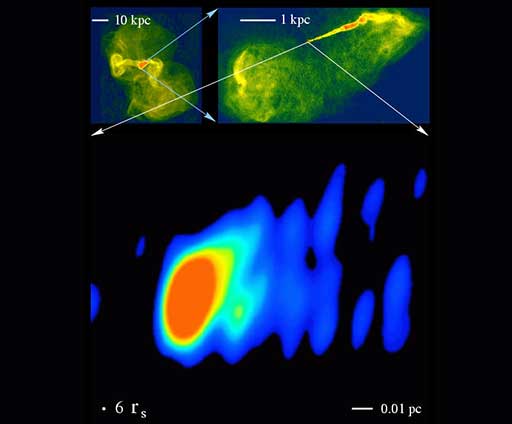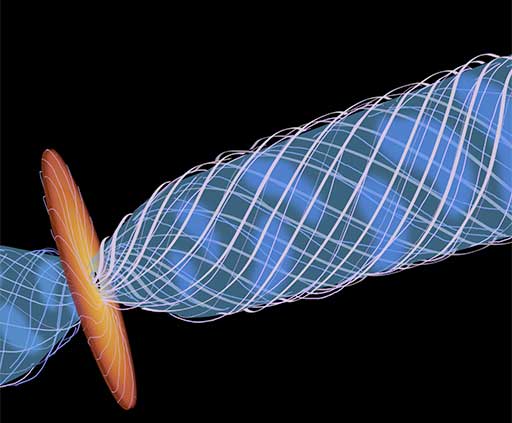Astronomers have gained their first glimpse of the mysterious region near a black hole at the heart of a distant galaxy, where a powerful stream of subatomic particles spewing outward at nearly the speed of light is formed into a beam, or jet, that then goes nearly straight for thousands of light-years. The astronomers used radio telescopes in Europe and the U.S., including the (NSF) to make the most detailed images ever of the center of the galaxy M87, some 50 million light-years away.
“This is the first time anyone has seen the region in which a cosmic jet is formed into a narrow beam,” said Bill Junor of the University of New Mexico, in Albuquerque. “We had always speculated that the jet had to be made by some mechanism relatively near the black hole, but as we looked closer and closer to the center, we kept seeing an already-formed beam. That was becoming embarrassing, because we were running out of places to put the formation mechanism that we knew had to be there.”
Junor, along with John Biretta and Mario Livio of the Space Telescope Science Institute, in Baltimore, MD, now have shown that M87’s jet is formed within a few tenths of a light-year of the galaxy’s core, presumed to be a black hole three billion times more massive than the sun. In the formation region, the jet is seen opening widely, at an angle of about 60 degrees, nearest the black hole, but is squeezed down to only 6 degrees a few light-years away.
“The 60-degree angle of the inner part of M87’s jet is the widest such angle yet seen in any jet in the universe,” said Junor. “We found this by being able to see the jet to within a few hundredths of a light-year of the galaxy’s core — an unprecedented level of detail.” The scientists reported their findings in the October 28 issue of the journal Nature.
At the center of M87, material being drawn inward by the strong gravitation of the black hole is formed into a rapidly-spinning flat disk, called an accretion disk. The subatomic particles are thought to be pushed outward from the poles of this disk. The scientists believe that magnetic fields in the disk are twisted tightly as the disk spins and then channel the electrically-charged particles into a pair of narrow jets.
“ supports this idea of magnetic fields doing the work of forming the stream of particles into a narrow jet,” said Biretta.
Jets such as the one in M87 are seen emerging from numerous galaxies throughout the universe. “What we learn about how M87’s jet is formed and shaped can be applied to others,” said Livio. “These jets coming from radio galaxies and quasars are among the greatest ‘particle accelerators’ in the universe, but we don’t fully understand how they work. This new information will help scientists decipher the physics of these powerful ‘engines,'” he added.
“We can see such jets very far away, even at distances of billions of light-years,” said Junor. “They are fascinating to us because they show how nature is somehow using the accretion disk and the jet to tap into the enormous gravitational energy of a black hole and use that energy to ‘light up’ the outer regions of the galaxy.”
“We have never thought these jets are created fully-formed,” said Biretta. “They need some space in which to reach the stable configuration we see at larger scales. We now have seen that space for the first time, and this will help show which theoretical models might be right.” He added that “magnetic fields are almost certainly involved,” and said that future radio-telescope observations will attempt to find evidence of the magnetic fields.
The astronomers studied M87 because it is one of the nearest jet-emitting galaxies and its strong radio emission made it an excellent target for radio telescopes. In addition to the VLBA, a continent-wide radio-telescope system, they used the NSF’s a radio telescope near Socorro, NM, and radio telescopes in Germany, Italy, Finland, Sweden and Spain. The signals from all the telescopes were combined to produce an image with extremely great resolution, or ability to discern fine detail. The combination of radio telescopes formed, in effect, a telescope the size of the Earth. In addition to using NSF’s VLBA, Junor received financial support for his research from the NSF. Biretta and Livio received support from NASA.
Both radio observations with the VLBA and optical observations with the Hubble Space Telescope have measured the motions of concentrations of material in M87’s jets, and have shown the material to be moving at apparent speeds greater than that of light. This “superluminal” motion is a geometric illusion created by material moving nearly, but under, the speed of light, but in a direction somewhat toward the Earth.
M87 also is known by radio astronomers as Virgo A, the strongest emitter of radio waves in the constellation Virgo. The galaxy was discovered by the French astronomer Charles Messier in 1781. The jet was first seen in 1918 by Lick Observatory astronomer Heber Curtis, who described it as “a curious straight ray.” The galaxy’s radio emission was first observed by Australian astronomers in 1948/49. M87 is the largest of thousands of galaxies in the Virgo Cluster of galaxies. The Local Group of galaxies, of which our own Milky Way is a member, is in the outskirts of the Virgo Cluster.
The VLA and VLBA are instruments of the National Radio Astronomy Observatory, a facility of the National Science Foundation, operated under cooperative agreement by Associated Universities, Inc. The Space Telescope Science Institute is operated by the Association of Universities for Research in Astronomy, Inc. for NASA, under contract with NASA’s Goddard Space Flight Center, Greenbelt, MD.
Contact:
Dave Finley, Public Information Officer
(505) 835-7302
Ray Villard, Space Telescope Science Institute
(410) 338-4514
















